Front of forearm
Question 1. Describe the flexor retinaculum at wrist in brief.
Answer.
The flexor retinaculum is a strong fibrous band formed by the thickening of deep fascia in front of carpal bones (anatomical wrist). It bridges the anterior concavity of carpus and converts it into an osseofibrous tunnel called carpal tunnel.
Attachments
It is rectangular in shape and attached as follows:
- Medially, to pisiform bone and hook of Hamate
- Laterally, to tubercle of scaphoid and crest of trapezium
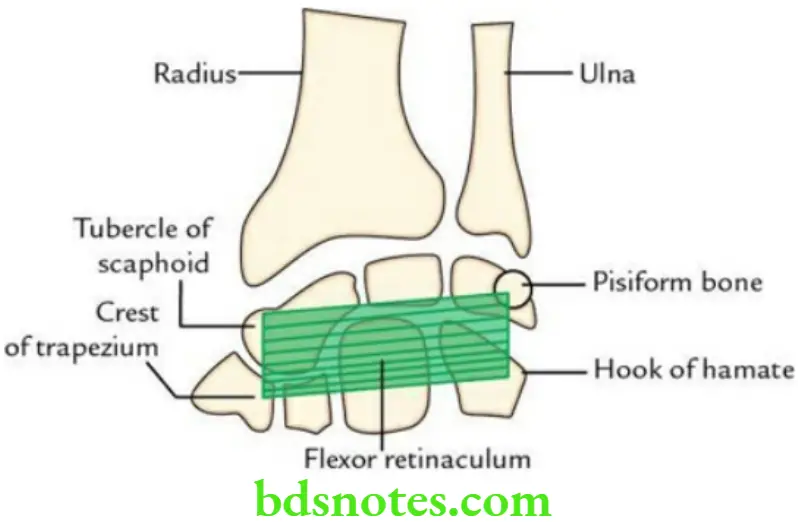
Features
- Converts the concavity of carpus into an osseofibrous tunnel – the carpal tunnel.
- Proximally, it gives attachment to the tendon of palmaris longus.
- Distally, it gives attachment to the apex of palmar aponeurosis.
Superficial relations
These are
- Ulnar artery and nerve
- Palmar cutaneous branch of median nerve
- Tendon of palmaris longus
- Superficial palmar branch of radial artery
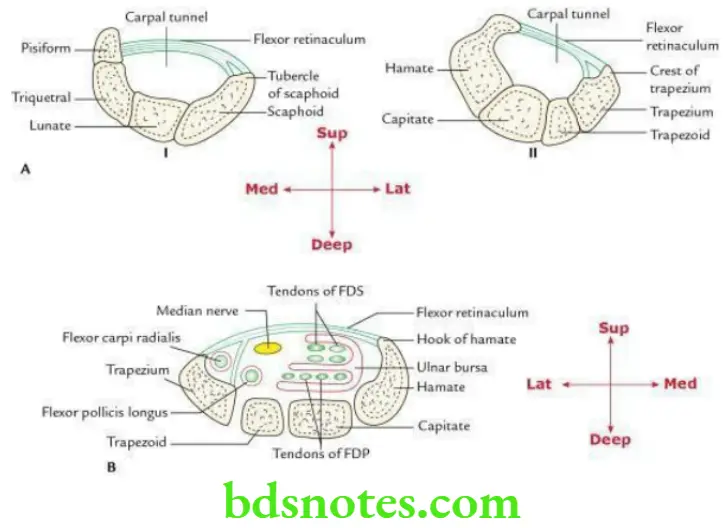
Question 2. Enumerate the structures passing deep to the flexor retinaculum/carpal tunnel.
Answer.
The structures passing deep to the flexor retinaculum are
- Median nerve
- Four tendons of the flexor digitorum superficialis
- Four tendons of the flexor digitorum profundus
- Tendon of the flexor pollicis longus
- Ulnar bursa
- Radial bursa
Question 3. Enumerate the superficial muscles on the front of forearm.
Answer.
They are five in number. From medial to lateral side, these are
- Flexor carpi ulnaris
- Palmaris longus
- Flexor digitorum superficialis
- Flexor carpi radialis
- Pronator teres
Question 4. Give the origin, insertion, nerve supply and actions of pronator teres.
Answer.
Origin
It arises by two heads.
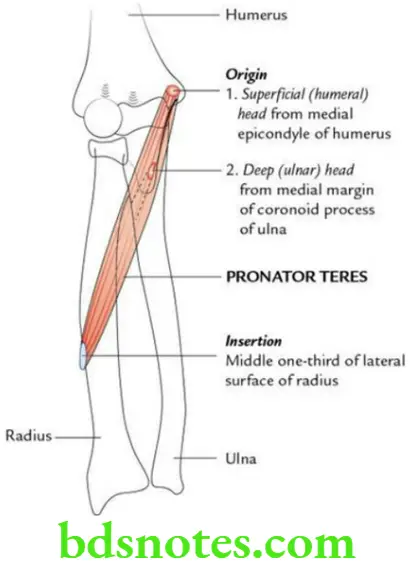
Humeral head:
From the lower part of the medial epicondyle of the humerus.
Ulnar head:
From the medial border of the coronoid process of ulna.
Read And Learn More: Selective Anatomy Notes And Question And Answers
Insertion
Into the lateral surface of the radius at its maximum convexity (middle of the lateral border of the radial shaft).
Nerve supply
Median nerve as it passes between its two heads of pronator teres.
Action
Pronation of the forearm.
Question 5. Give the origin and insertion of superficial muscles of the forearm in a tabular form.
Answer.
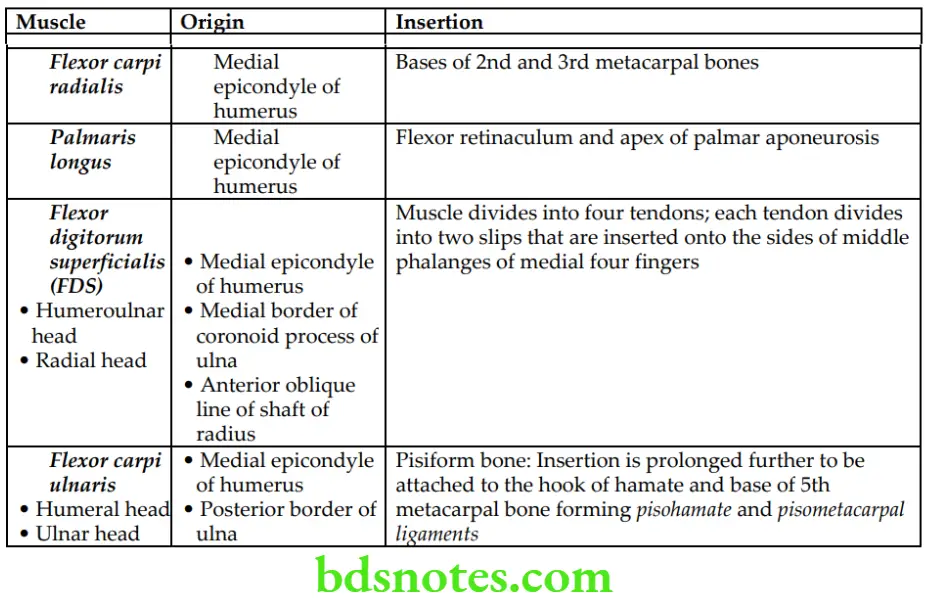
Question 6. Enumerate the deep muscles on the front of forearm.
Answer.
These are three in number as follows:
- Flexor pollicis longus (FPL)
- Flexor digitorum profundus (FDP)
- Pronator quadratus
Question 7. Give the origin and insertion of deep muscles on the front of forearm in a tabular form.
Answer.
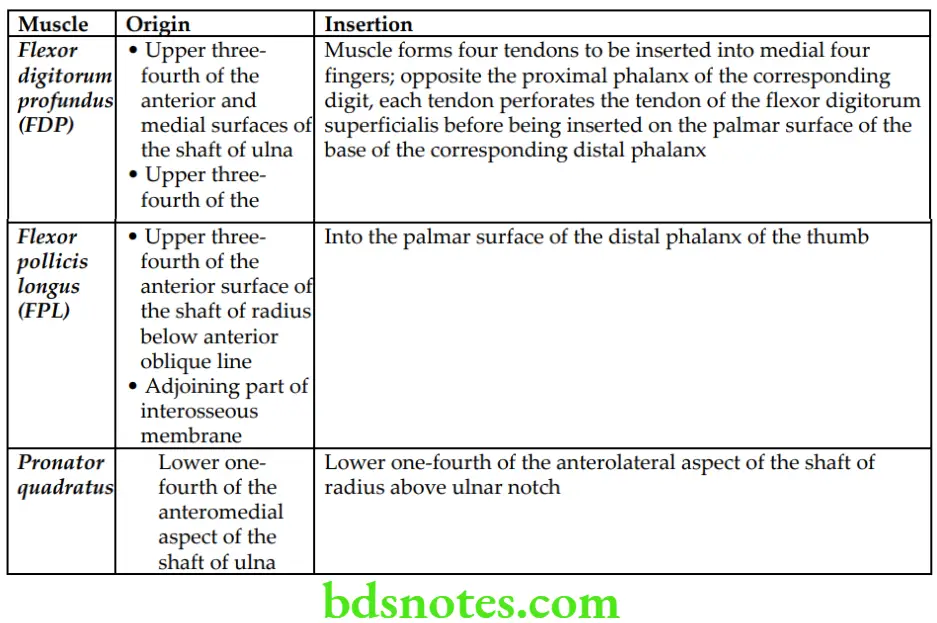
Question 8. Enumerate the structures on the front of the wrist.
Answer.
From lateral to medial side, these are
- Radial artery
- Tendon of flexor carpi radialis (FCR)
- Median nerve
- Tendon of palmaris longus
- Tendon of flexor digitorum superficialis (FDS)
- Ulnar artery
- Ulnar nerve
- Tendon of flexor carpi ulnaris
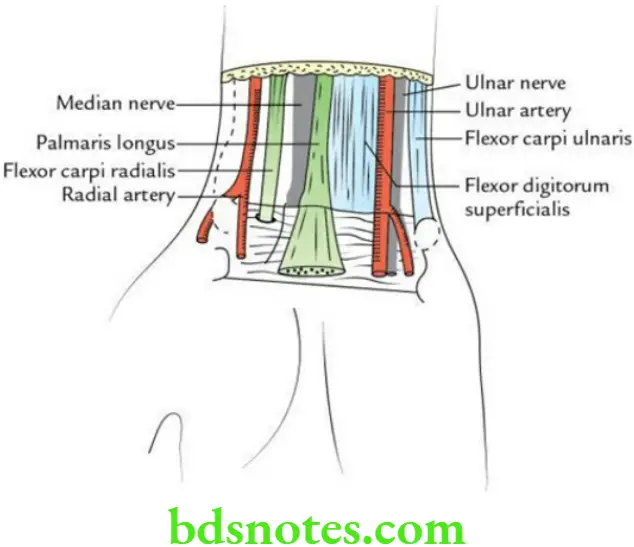
Back of forearm
Question 1. Describe the extensor retinaculum at wrist in brief.
Answer.
The extensor retinaculum is a strong fibrous band about 2 cm broad running obliquely downwards and medially on the back of the wrist. It is formed by the thickening of deep fascia. It holds the extensor tendons in place.
Attachments
Laterally to: Lower 2 cm of anterior border of radius.
Medially to:
- Styloid process of ulna
- Triquetral bone
- Pisiform bone
Compartments
Space deep to extensor retinaculum is divided into six osseo-fascial compartments by septa, extending from retinaculum to the ridges on the dorsal aspect of the lower ends of radius and ulna. The compartments are numbered I–VI from lateral to medial side.
Question 2. Enumerate the structures passing through various compartments underneath the extensor retinaculum.
Answer.
The structures passing through various compartments underneath the extensor retinaculum are:
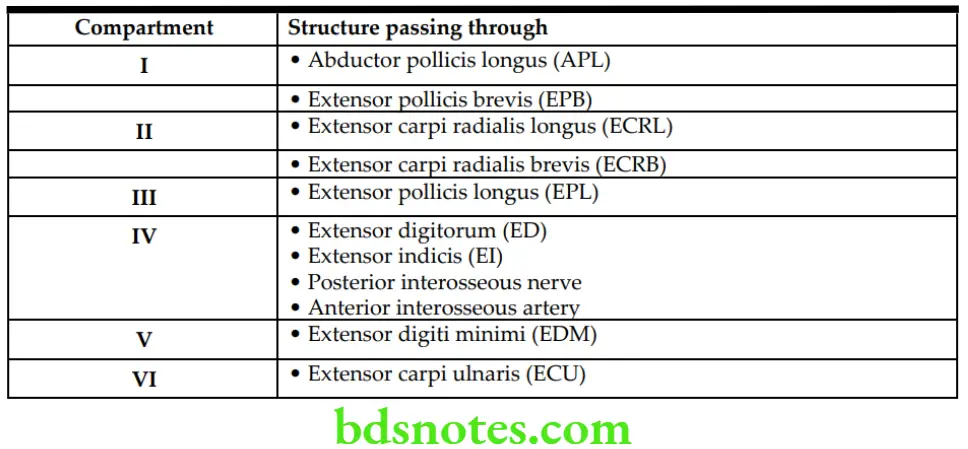
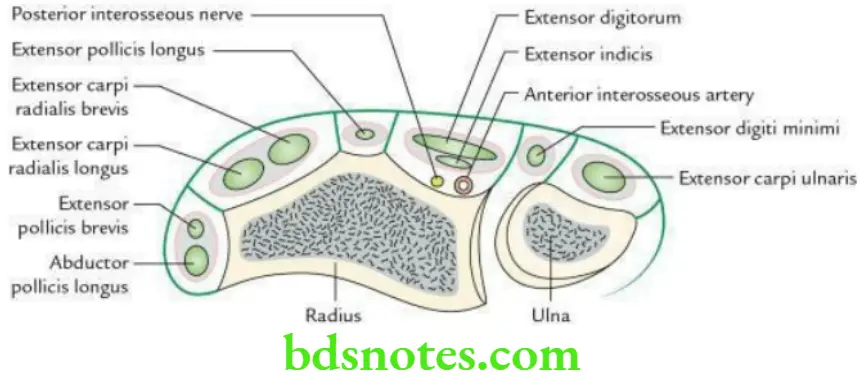
Question 3. Enumerate the superficial muscles on the back of forearm.
Answer.
They are seven in number as follows:
- Anconeus
- Brachioradialis
- Extensor carpi radialis longus
- Extensor carpi radialis brevis
- Extensor digitorum
- Extensor digiti minimi
- Extensor carpi ulnaris
Question 4. Give the origin and insertion of superficial muscles on the back of forearm.
Answer.
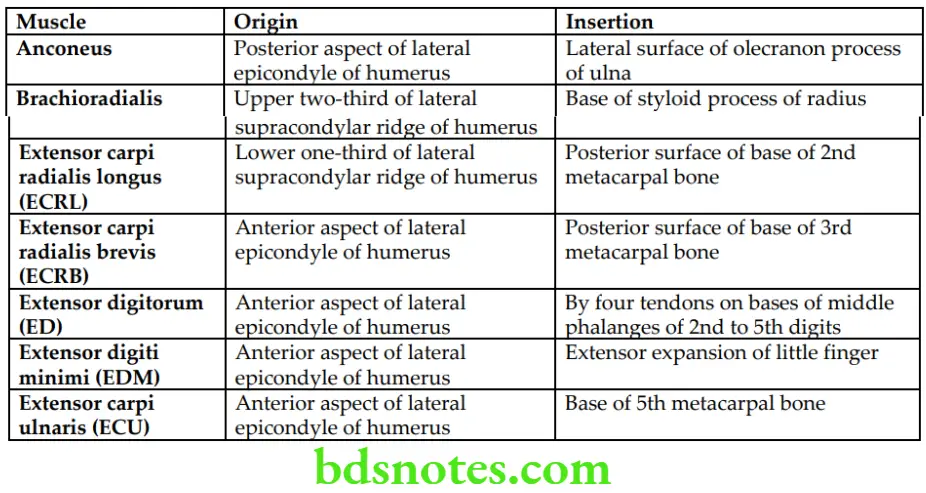
Question 5. Give the origin, insertion, nerve supply and actions of the brachioradialis.
Answer.
Origin
Upper two-third of the lateral supracondylar ridge of the humerus.
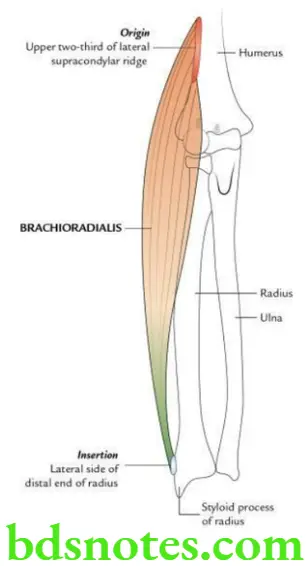
Insertion
Lateral aspect of lower end of radius just above its styloid process.
Nerve supply
Radial nerve (C5, C6).
Actions
- Flexion of the elbow in the midprone position as required when carrying the apron over the shoulder.
- Actively involved in alternate movements of flexion and extension of elbow, acting like a shunt muscle.
- It also helps in both supination and pronation.
Question 6. Enumerate the deep muscles on the back of forearm.
Answer.
These are five in number and as follows:
- Supinator
- Abductor pollicis longus (APL)
- Extensor pollicis brevis (EPB)
- Extensor pollicis longus (EPL)
- Extensor indicis
Question 7. Give the origin and insertion of deep muscles on the back of forearm in a tabular form.
Answer.
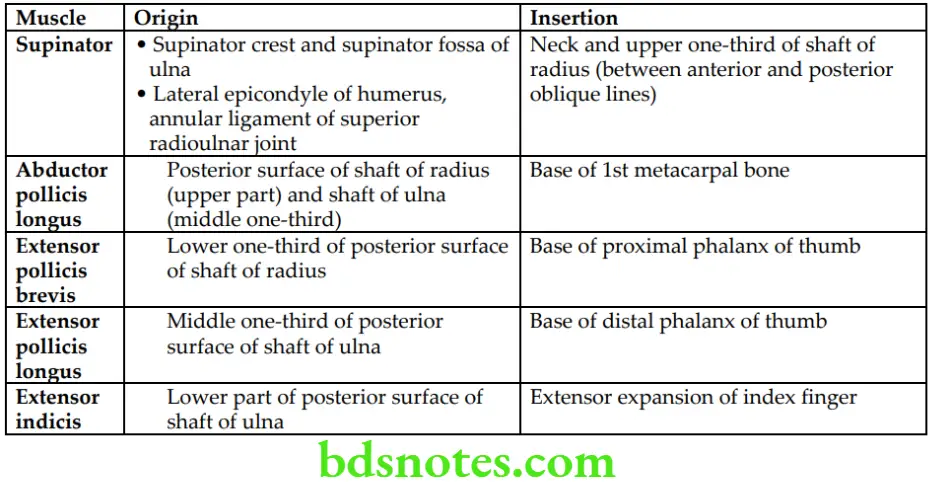
Question 8. Give the origin, insertion, nerve supply and action of the supinator muscle.
Answer.
Origin
Deep part:
From supinator crest of ulna and triangular area in front of it (supinator fossa).
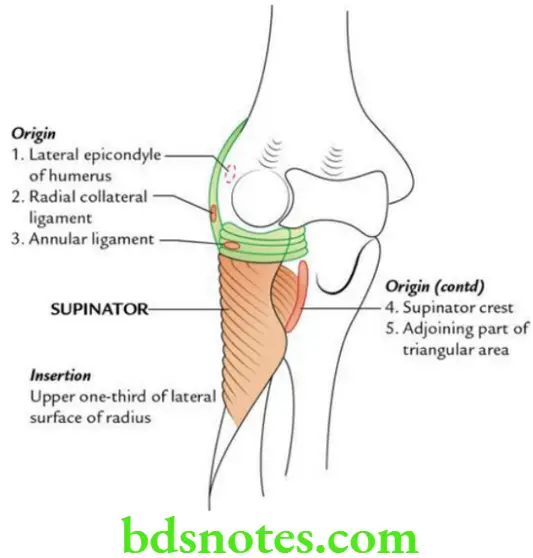
Superficial part:
From lateral epicondyle of humerus, radial collateral ligament and annular ligament.
Insertion
Upper one-third of the lateral surface of the radius between anterior and posterior oblique lines.
Nerve supply
Posterior interosseous nerve (i.e. deep branch of the radial nerve [C6, C7]).
Action
Supination of the forearm.
Question 9. Describe the posterior interosseous nerve in brief.
Answer.
It is the deep terminal branch of the radial nerve.
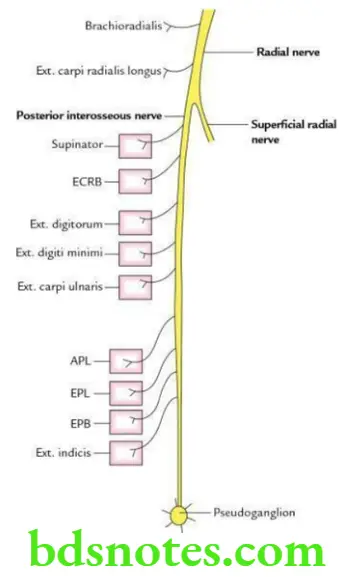
Origin
It arises from radial nerve just above cubital fossa in front of lateral epicondyle.
Course
The nerve winds around the lateral side of radius and passes through the supinator muscle (between its superficial and deep laminae) to appear on the back of forearm.
Termination
On the back of wrist where it ends by forming a pseudoganglion.
Branches
- In the cubital fossa, it supplies:
- Extensor carpi radialis brevis
- Supinator (as it passes through the muscle)
- In the back of forearm, it supplies:
- Abductor pollicis longus
- Extensor pollicis brevis
- Extensor pollicis longus
- Extensor digitorum
- Extensor indicis
- Extensor digiti minimi
- Extensor carpi ulnaris
Applied anatomy
The lesion of posterior interosseous nerve produces wrist drop due to unopposed action of the flexor muscles.

Leave a Reply